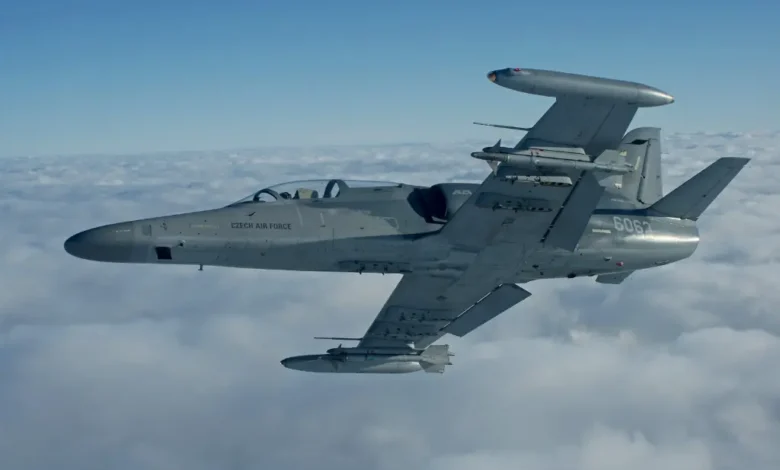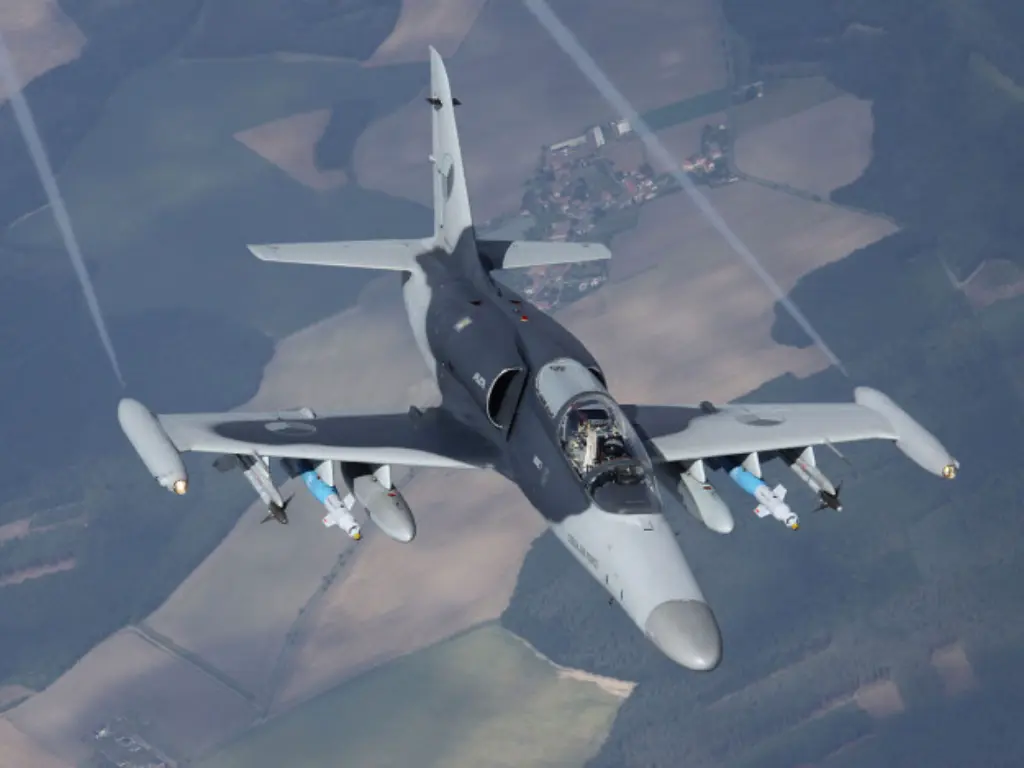Aero L-159 ALCA

The Aero L-159 ALCA (Advanced Light Combat Aircraft) is a subsonic, multirole light combat aircraft developed by Aero Vodochody for the Czech Air Force. First flown in 1997 and introduced in 2000, the L-159 is designed for close air support, reconnaissance, and advanced pilot training. It is equipped with modern avionics and weapon systems, making it a versatile and cost-effective platform for various combat and training roles.
Fact Sheet
| Role | Light combat and trainer aircraft |
|---|---|
| Manufacturer | Aero Vodochody |
| First Flight | 1997 |
| Service Entry | 2000 |
| Crew | 1 (L-159A) or 2 (L-159B/T1) |
Specifications
| Length | 12.72 m (41 ft 9 in) |
|---|---|
| Wingspan | 9.54 m (31 ft 4 in) |
| Height | 4.87 m (16 ft) |
| Empty Weight | 4,350 kg (9,590 lb) |
| Max Takeoff Weight | 8,000 kg (17,637 lb) |
| Powerplant | 1 × Honeywell F124-GA-100 turbofan |
| Thrust | 6,300 lbf (28 kN) |
| Max Speed | Mach 0.82 (990 km/h; 615 mph) |
| Service Ceiling | 13,200 m (43,300 ft) |
| Range | 1,570 mi (2,530 km) ferry range |
| Rate of Climb | ~10,000 ft/min (51 m/s) |
Avionics & Armament
| Main Radar | Optional radar for combat variants |
|---|---|
| Avionics | Advanced avionics suite, glass cockpit |
| Armament | One 20-mm Plamen cannon (optional); Up to 7 external hardpoints for: – Air-to-air missiles (AIM-9 Sidewinder) – Air-to-ground munitions (bombs, rockets) – Precision-guided bombs – External fuel tanks |
Notable Features
- Cost-effective solution for light combat and training missions.
- Multirole capability for close air support and reconnaissance.
- Advanced avionics for modern combat scenarios.
- Export success with operators including Iraq and the Czech Republic.
- Continuously upgraded with new systems and configurations.

Aero L-159 ALCA: The Czech Light Combat Aircraft
The Aero L-159 ALCA (Advanced Light Combat Aircraft) is a single-engine, light multirole combat aircraft and advanced jet trainer developed and manufactured by Aero Vodochody in the Czech Republic. A modern evolution of the highly successful L-39 Albatros family, the L-159 was designed for both light attack and advanced pilot training for 4th and 5th generation fighters.
L-159 Development & Purpose
The L-159 program was initiated in the mid-1990s as a more capable successor to the L-39/L-59 series, specifically to meet the requirements of the Czech Air Force for a light attack aircraft. Unlike its predecessors which were primarily trainers, the L-159 ALCA was conceived from the outset with significant combat capabilities, including radar and advanced Western avionics. The first prototype flew on August 2, 1997, and it entered service with the Czech Air Force in 2000. While a large number were initially ordered, some were later placed in storage or sold to other operators.
L-159 Design Features: Agile & Robust
The L-159 retains the robust and straightforward design philosophy of its Albatros lineage, but with significant enhancements for combat roles.
- Single Engine Powerplant: The L-159 is powered by a single Honeywell/ITEC F124-GA-100 turbofan engine. This non-afterburning engine provides 28.2 kN (6,300 lbf) of thrust, allowing for a maximum speed of 936-955 km/h (582-593 mph) at sea level.
- Rugged Airframe: Designed for durability and the ability to operate from unpaved surfaces, making it suitable for dispersed operations.
- High Maneuverability: The aircraft boasts agile handling characteristics, making it effective in air-to-ground attack and close air support roles.
- Service Life: The airframe is designed for a service life of up to 8,000 flight hours.
- Ejection System: Features a VS-2C zero-zero ejection seat, ensuring safe pilot escape even at zero altitude and zero speed.
L-159 Avionics & Armament: Western Integration & NATO Compatibility
A key differentiator for the L-159 from earlier Aero trainers is its integration of Western avionics, particularly for the single-seat combat variant.
- FIAR Grifo-L Radar: The single-seat L-159A is equipped with the Grifo-L multi-mode pulse-Doppler radar, providing all-weather, day/night operational capability, and allowing for target detection and tracking.
- Advanced Cockpit: Features a modern cockpit with a Head-Up Display (HUD), Multi-Function Displays (MFDs) (color in later upgrades), and Hands-On-Throttle-And-Stick (HOTAS) controls for reduced pilot workload.
- Electronic Warfare (EW) System: Includes a BAE Systems Sky Guardian 200 radar warning receiver (RWR) for self-protection.
- Weapon Hardpoints: The L-159 has 7 external hardpoints (3 under each wing and 1 under the fuselage) with a total payload capacity of 2,340 kg (5,159 lb).
- Flexible Armament: It can carry a wide range of NATO-standard weaponry:
- Gun Pods: Up to three ZVI Plamen PL-20 20x102mm gun pods.
- Air-to-Air Missiles (AAMs): Primarily AIM-9L/M Sidewinder (short-range infrared-guided). It also has provisions for, but is not typically fitted with, AIM-120 AMRAAM (medium-range active radar-guided). Future integration of IRIS-T and AIM-132 ASRAAM has been mentioned for some variants.
- Air-to-Ground Missiles (AGMs): Capable of deploying AGM-65 Maverick (air-to-surface).
- Bombs: Various unguided general-purpose bombs (e.g., Mk 82, Mk 83), laser-guided bombs (LGBs) like GBU-12 Paveway II and GBU-16 Paveway II, and cluster bombs (e.g., CBU-87 Combined Effects Munition).
- Rockets: Can carry various rocket pods (e.g., LAU-5002/5003 for CRV7 70mm rockets).
L-159 Variants & Modernization
The L-159 family includes several variants, primarily distinguished by their seating configuration and role:
- L-159A ALCA: The single-seat light combat aircraft variant, initially the primary focus of production for the Czech Air Force. This variant is no longer in production.
- L-159B: A prototype two-seat combat-capable trainer variant.
- L-159T1: A two-seat trainer variant for the Czech Air Force, created by modifying stored L-159A airframes. The first L-159T1 flew in March 2007.
- L-159T1+: An upgraded version of the T1, featuring enhanced avionics and systems.
- L-159T2: A new production two-seat advanced trainer and light attack aircraft, with a reinforced airframe, new glass cockpit, upgraded communications, and compatibility with a wider range of weapons.
- L-159 Advanced Trainer (AT): A proposed two-seat variant marketed for export, often incorporating features from the T2.
- L-159 Light Attack (LA): A proposed single-seat variant marketed for export.
L-159 Operators & Operational History
The L-159 ALCA has been operated by several air forces, though its initial widespread adoption by the Czech Republic faced challenges.
- Czech Republic (Czech Air Force): The primary and original operator. While a large number (72) were initially ordered, only a smaller operational fleet (around 24 aircraft, including L-159A and two-seat trainers) has been maintained for economic reasons. They are used for light attack, close air support, air policing, and advanced pilot training.
- Iraq (Iraqi Air Force): Acquired 12 L-159s (including a mix of single-seat and two-seat variants, some ex-Czech Air Force stock) starting in 2014. These aircraft have been actively used in combat operations against ISIS, providing close air support and reconnaissance, marking the L-159’s first combat deployment.
- United States (Draken International): A private aggressor air services provider, Draken International, acquired 21 L-159Es (ex-Czech Air Force L-159As) to provide adversary training for the U.S. military. These aircraft are known for their modern avionics and performance that simulates contemporary threats.
L-159 Combat Experience & Role
The Aero L-159 ALCA has gained combat experience with the Iraqi Air Force in its fight against the Islamic State. It has proven effective in close air support (CAS) and light attack roles, demonstrating its ability to deliver precision-guided munitions in real-world scenarios. For the Czech Air Force, it serves as a versatile platform for both fighter pilot training (transitioning pilots to types like the JAS 39 Gripen) and light attack/air policing duties within NATO. Its relatively low operating cost and NATO compatibility make it an attractive option for certain air forces.



